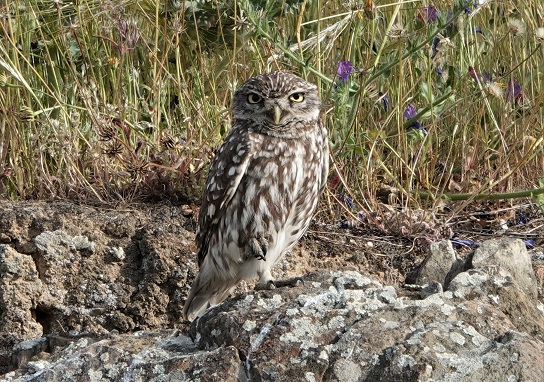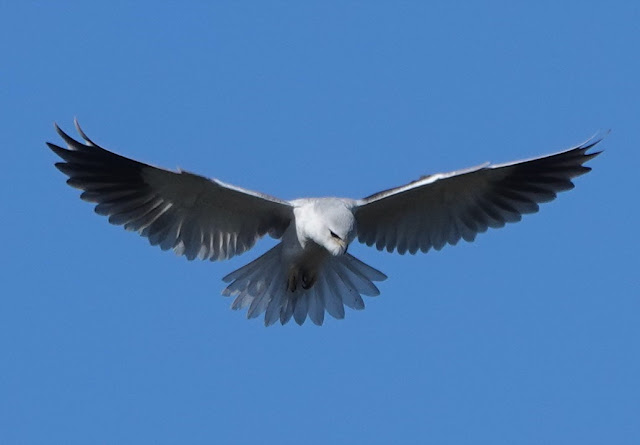A very late Woodchat Shrike and displaying Black-winged Kites

Another two superb days in the field, with some surprises and memorable sightings. The day before yesterday we ventured out on the plains to the west of us. It is curious how varied the landscape is at the moment in terms of "greenness". After the long dry summer we have had very few days of rain this autumn and most of the open ground has the barest of flushes of new growth. Farmers are still having to provide supplementary feed. Yet to the north of Trujillo there is a zone stunning in its autumnal beauty of emerald green grass and yellow crucifers in bloom. Our friend that lives there is convinced that it is thanks to some localised showers that missed the rest of us.
Most of our route was through drier terrain. At our first stop we found two groups of Great Bustard (37 birds in total) and watched a sky seemingly full of a flock of about 100 Pin-tailed Sandgrouse, which split into a myriad of smaller parties (twos and threes) circling and calling. A Carrion Crow was an unusual record here, but one frequented the area last year, so perhaps it is the same individual returning. We next visited a beautiful rocky valley where a pair of Bonelli's Eagles watched us from the top of a pylon. Out on the plains again, we came across two more parties of Pin-tailed Sandgrouse and a couple of Black-bellied Sandgrouse too, but what was most surprising was an adult Woodchat Shrike which fly across the road in front of us and then found again perched on a fence nearby, close enough for a photo to be taken. Up until now the latest ever recorded in Extremadura was late September, so this is an extraordinarily late bird. Close by we watched a female Merlin feeding on what was probably a Meadow Pipit on the ground. We spent the best part of the afternoon beside a small reservoir where a few Cranes rested along with Cormorants and Black-headed Gulls. But the highlight undoubtedly was the family of three Otters which were enchanting as they played on a grassy bank, tumbling over each other, play-biting and chasing each other. We completed the day in another stretch of steppe, finding more Great Bustards and a Common Starling amongst a flock of Spotless Starlings. The Spanish name for the former means "Painted Starling" an apt name for its startlingly attractive winter plumage.
Yesterday was spent in the rice-growing area where the harvest is now almost finished. At this time of year the area is dominated by rice stubble fields, with family parties and some large flocks of Cranes feed. A few White Stork were also present and, following the combines, large flocks of Cattle Egret and Black-headed Gulls. Some fields had been ploughed, attracting small numbers of waders: Kentish and Ringed Plover, a Black-tailed Godwit, Greenshank, Dunlin and Little Stint. We had brief sightings of two or three wintering Bluethroat flying into ditches. A couple of male Hen Harrier and one ring-tail were seen quartering the stubble fields, whilst the embanked pool that I always check had a Black Stork and a Great White Egret. We found three groups of Great Bustard during the day and also enjoyed the sight of a flock of about 50 Little Bustard in flight, turning simultaneously and thus appearing alternately white and brown. So warm was it during the middle of the day that even a Viperine Snake was found basking ona dirt track.
For me the most memorable part of the day was a pair of Black-winged Kite. We watched them perched in separate trees. One then flew to the other and they mated. The male then took off and performed the most beautiful display flight, calling a soft "peee" and rising higher and higher in a wide spiral, performing a hovering, fluttering flight the whole time. It flew higher and higher until we lost sight of it against the clear blue sky.
Most of our route was through drier terrain. At our first stop we found two groups of Great Bustard (37 birds in total) and watched a sky seemingly full of a flock of about 100 Pin-tailed Sandgrouse, which split into a myriad of smaller parties (twos and threes) circling and calling. A Carrion Crow was an unusual record here, but one frequented the area last year, so perhaps it is the same individual returning. We next visited a beautiful rocky valley where a pair of Bonelli's Eagles watched us from the top of a pylon. Out on the plains again, we came across two more parties of Pin-tailed Sandgrouse and a couple of Black-bellied Sandgrouse too, but what was most surprising was an adult Woodchat Shrike which fly across the road in front of us and then found again perched on a fence nearby, close enough for a photo to be taken. Up until now the latest ever recorded in Extremadura was late September, so this is an extraordinarily late bird. Close by we watched a female Merlin feeding on what was probably a Meadow Pipit on the ground. We spent the best part of the afternoon beside a small reservoir where a few Cranes rested along with Cormorants and Black-headed Gulls. But the highlight undoubtedly was the family of three Otters which were enchanting as they played on a grassy bank, tumbling over each other, play-biting and chasing each other. We completed the day in another stretch of steppe, finding more Great Bustards and a Common Starling amongst a flock of Spotless Starlings. The Spanish name for the former means "Painted Starling" an apt name for its startlingly attractive winter plumage.
Yesterday was spent in the rice-growing area where the harvest is now almost finished. At this time of year the area is dominated by rice stubble fields, with family parties and some large flocks of Cranes feed. A few White Stork were also present and, following the combines, large flocks of Cattle Egret and Black-headed Gulls. Some fields had been ploughed, attracting small numbers of waders: Kentish and Ringed Plover, a Black-tailed Godwit, Greenshank, Dunlin and Little Stint. We had brief sightings of two or three wintering Bluethroat flying into ditches. A couple of male Hen Harrier and one ring-tail were seen quartering the stubble fields, whilst the embanked pool that I always check had a Black Stork and a Great White Egret. We found three groups of Great Bustard during the day and also enjoyed the sight of a flock of about 50 Little Bustard in flight, turning simultaneously and thus appearing alternately white and brown. So warm was it during the middle of the day that even a Viperine Snake was found basking ona dirt track.
For me the most memorable part of the day was a pair of Black-winged Kite. We watched them perched in separate trees. One then flew to the other and they mated. The male then took off and performed the most beautiful display flight, calling a soft "peee" and rising higher and higher in a wide spiral, performing a hovering, fluttering flight the whole time. It flew higher and higher until we lost sight of it against the clear blue sky.




Comments